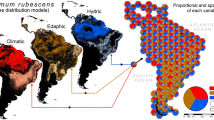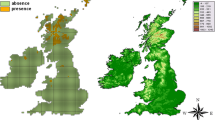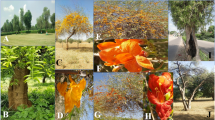Abstract
In the face of climate warming, maps of potential tree species distribution can support forest management planning at coarse scales. For evaluating future suitability, conditions at the rear edge, i.e. at the meridional and lower altitudinal limits of species distribution, are of particular importance. Therefore, we present the concept of climatic marginality (distance to the rear edge) as a metric for the susceptibility against climate warming. Using a statistic niche model fitted to observed and potential beech occurrence in ICP Forests Level I monitoring plots and WorldClim data, we evaluate the modelled xeric limit of European beech based on the Ellenberg’s climate quotient involving thresholds suggested by Ellenberg and other authors. The applicability of the marginality index was tested with independent study sites. Despite the limitations of niche modelling, estimated climatic thresholds of beech were well in accordance with textbook knowledge and recent research. The regional patterns of climatic marginality were plausible and more meaningful with respect to the rear edge compared to conventional niche model outputs. In terms of climatic marginality, most regions in Central Europe are far from the xeric limit of beech. Evaluation based on independently sampled sites indicated that inclusion of soil and topography (microclimate) may permit implications at the local scale, e.g. growth potential estimations.








Similar content being viewed by others
References
Alberto FJ, Aitken SN, Alía R, González-Martínez SC, Hänninen H, Kremer A, Lefèvre F, Lenormand T, Yeaman S, Whetten R, Savolainen O (2013) Potential for evolutionary responses to climate change—evidence from tree populations. Glob Change Biol 19:1645–1661
Attorre F, Francesconi F, De Sanctis M, Alfò M, Martella F, Valenti R, Vitale M (2014) Classifying and mapping potential distribution of forest types using a finite mixture model. Folia Geobot 49:313–335. doi:10.1007/s12224-012-9139-8
Austin MP, van Niel KP (2011) Improving species distribution models for climate change studies: variable selection and scale. J Biogeogr 38:1–8
Austin MP, Nicholls AO, Margules CR (1990) Measurement of the realised qualitative niche: environmental niches of five Eucalyptus species. Ecol Monogr 60:161–177
Berki I, Rasztovits E, Móricz N, Mátyás C (2009) Determination of the drought tolerance limit of beech forests and forecasting their future distribution in Hungary. Cereal Res Commun 37:613–616
Bitterlich W (1984) The relascope idea. Commonwealth Agricultural Bureaux, Farnham Royal
Bohn U, Neuhäusl R, Gollub G, Hettwer C, Neuhäuslova Z, Raus T, Schlüter H, Weber H (2003) Map of the natural vegetation of Europe, scale 1:2500000. Parts 1–3. Landwirtschaftsverlag, Münster-Hiltrup
Bolte A, Czajkowski T, Kompa T (2007) The north-eastern distribution range of European beech—a review. Forestry 80:413–429
Bolte A, Ammer C, Löf M, Nabuurs GJ, Schall P, Spathelf P (2010) Adaptive forest management—a prerequisite of sustainable forestry in the face of climate change. In: Spathelf P (ed) Sustainable forest management in a changing world: European perspective. Managing forest ecosystems 19. Springer, Dordrecht, pp 115–139
Booth TH (1985) A new method to assist species selection. Commonw Forest Rev 64:241–250
Booth TH, Williams KJ (2012) Developing biodiverse plantings suitable for changing climatic conditions 1: underpinning scientific methods. Ecol Manage Restor 13:267–273
Bréda N, Huc R, Granier A, Dreyer E (2006) Temperate forest trees and stands under severe drought: a review of ecophysiological responses, adaptation processes and long-term consequences. Ann Forest Sci 63:625–644
Chen K, Dorado-Liñán I, Akhmetzyanov L, Menzel A (accepted) Climate drivers and NAO influence on beech growth at marginal sites across the Mediterranean. Clim Res
Cools N, Vesterdal L, De Vos B, Vanguelova E, Hansen K (2014) Tree species is the major factor explaining C:N ratios in European forests. Forest Ecol Manage 311:3–16
Czúcz B, Gálhidy L, Mátyás C (2011) Present and forecasted xeric climatic limits of beech and sessile oak distribution at low altitudes in Central Europe. Ann Forest Sci 68:99–108
De Vos B, Cools N (2011) Second European forest soil condition report. Volume I: results of the BioSoil Soil Survey. INBO.R.2011.35. Research Institute for Nature and Forest, Brussels
Dobbertin M (2005) Tree growth as indicator of tree vitality and of tree reaction to environmental stress: a review. Eur J Forest Res 124:319–333
Dormann CF (2007) Promising the future? Global change projections of species distributions. Basic Appl Ecol 8:387–397
EC/JRC (2012) European Commission—Joint Research Centre, Institute for Environment and Sustainability: Glossary of Soil Terms. http://eusoils.jrc.ec.europa.eu/ESDB_Archive/glossary/Soil_Terms.html. Accessed 23 Jan 2015
Ellenberg H (1963) Vegetation Mitteleuropas mit den Alpen, 1st edn. Eugen Ulmer, Stuttgart
Ellenberg H (1988) Vegetation ecology of Central Europe, 1st edn. Cambridge University Press, Cambridge
Ellenberg H, Leuschner C (2010) Vegetation Mitteleuropas mit den Alpen. Eugen Ulmer, Stuttgart
Ewald J (2012) Vegetation databases provide a close-up on altitudinal tree species distribution in the Bavarian Alps. Biodiv Ecol 4:41–48
Falk W, Hempelmann N (2013) Species favourability shift in Europe due to climate change: a case study for Fagus sylvatica L. and Picea abies (L.) Karst. Based on an ensemble of climate models. J Climatol. doi:10.1155/2013/787250
Falk W, Mellert KH (2011) Species distribution models as a tool for forest management planning under climate change: risk evaluation of Abies Alba in Bavaria. J Veg Sci 22. doi:10.1111/j.1654-1103.2011.01294.x
Fang J, Lechovicz MJ (2006) Climatic limits for the present distribution of beech (Fagus L.) species in the world. J Biogeogr 33:1804–1819
Fischer R, Lorenz M, Köhl M, Mues V, Granke O, Iost S, van Dobben H, Reinds GJ, de Vries W (2010) The Condition of Forests in Europe. 2010 executive report. ICP Forests and European Commission, Hamburg
Franklin J (2009) Mapping species distributions—spatial inference and prediction. University Press, Cambrige
Franks SJ, Weber JJ, Aitken SN (2014) Evolutionary and plastic responses to climate change in terrestrial plant populations. Evol Appl 7:123–139
Freeman EA, Moisen G (2008) PresenceAbsence: An R Package for presence absence analysis. J Stat Softw 23(11):1–31. http://www.jstatsoft.org/v23/i11/paper. Accessed June 2010
Gärtner S, Reif A, Xystratis F, Sayer U, Bendagha N, Matzarakis A (2008) The drought tolerance limit of Fagus sylvatica forest on limestone in southwestern Germany. J Veg Sci 19:757–768
Guisan A, Zimmermann NE (2000) Predictive habitat distribution models in ecology. Ecol Model 135:147–186
Guisan A, Zimmermann NE, Elith J, Graham C, Phillips S, Peterson AT (2007) What matters for predicting spatial distributions of trees: techniques, data, or species characteristics? Ecol Monogr 77:615–630
Hampe A (2004) Bioclimate envelope models: what they detect and what they hide. Global Ecol Biogeogr 13:469–471
Hampe A, Petit RJ (2005) Conserving biodiversity under climate change: the rear edge matters. Ecol Lett 8:461–467
Hanewinkel M, Hummel S, Cullmann D (2009) Modelling and economic evaluation of forest biome shifts under climate change in Southwest Germany. Forest Ecol Manag 259:710–719
Hanewinkel M, Cullmann D, Schelhaas MJ, Nabuurs GJ, Zimmermann NE (2013) Climate change may cause severe loss in economic value of European forestland. Nature Clim Change 3:203–207
Hanewinkel M, Cullmann DA, Michiels HG, Kändler G (2014) Converting probabilistic tree species range shift projections into meaningful classes for management. J Environ Manage 134:153–165. doi:10.1016/j.jenvman.2014.01.010
Hargreaves GH, Allen RG (2003) History and evaluation of Hargreaves evapotranspiration equation. J Irrig Drain E-Asce. 129:53–63
Heegaard E (2002) The outer border and central border for species/environmental relationships estimated by non-parametric generalised additive models. Ecol Model 157:131–139
Hijmans RJ, van Etten J (2012) Raster: geographic analysis and modeling with raster data. R package version 2.0-12. http://CRAN.R-project.org/package=raster. Accessed 23 Jan 2015
Hijmans RJ, Cameron SE, Parra JL, Jones PG, Jarvis A (2005) Very high resolution interpolated climate surfaces for global land areas. Int J Climatol 25:1965–1978
Hirzel A, Lay Le (2008) Habitat suitability modelling and niche theory. J Appl Ecol 45:1372–1381
Hirzel A, Hausser J, Chessel D, Perrin N (2002) Ecological-niche factor analysis: how to compute habitat-suitability maps without absence data? Ecology 83:2027–2036
Huntley B, Bartlein PJ, Prentice IC (1989) Climate control of the distribution and abundance of beech (Fagus L.) in Europe and North America. J Biogeogr 16:551–560
IPCC (2013) Climate change 2013: the physical science basis. In: Stocker TF, Qin D, Plattner GK, Tignor M, Allen SK, Boschung J, Nauels A, Xia Y, Bex V, Midgley PM (eds) Contribution of working group I to the fifth assessment report of the intergovernmental panel on climate change. Cambridge University Press, Cambridge
Jackson ST, Overpeck JT (2000) Responses of plant populations and communities to environmental changes of the late Quaternary. Paleobiology 26:194–220
Jump AS, Hunt JM, Penuelas J (2006) Rapid climate change-related growth decline at the southern range edge of Fagus sylvatica. Glob Change Biol 12:2163–2174
Lakatos F, Molnár M (2009) Mass mortality of beech on Southwest Hungary. Acta Silv Lignaria Hung 5:75–82
Leathwick JR (2001) New Zealand’s potential forest pattern as predicted from current species-environment relationships. New Zeal J Bot 39:447–464
Lenoir J, Graae BJ, Aarrestad PA et al (2013) Local temperatures inferred from plant communities suggest strong spatial buffering of climate warming across Northern Europe. Global Change Biol 19:1470–1481
Liu CR, Berry PM, Dawson TP, Pearson RG (2005) Selecting thresholds of occurrence in the prediction of species distributions. Ecography 28:385–393
Mátyás C, Berki I, Czúcz B, Gálos B, Moricz N, Rasztovits E (2010) Future of beech in southeast Europe from the perspective of evolutionary ecology. Acta Silv Lignaria Hung 6:91–110
Mellert KH, Fensterer V, Küchenhoff H, Reger B, Kölling C, Klemmt HJ, Ewald J (2011) Hypothesis-driven species distribution models for tree species in the Bavarian Alps. J Veg Sci 22:635–646
Mellert KH, Deffner V, Küchenhoff H, Kölling C (2015) Modeling sensitivity to climate change and estimating the uncertainty of its impact: a probabilistic concept for risk assessment in forestry. Ecol Model 316:211–216
Miller J, Franklin J (2002) Predictive vegetation modeling with spatial dependence—vegetation alliances in the Mojave Desert. Ecol Model 57:227–247
Monserud RA, Leemans R (1992) Comparing global vegetation maps with Kappa statistic. Ecol Model 62:275–293
Morin X, Augspurger C, Chuine I (2007) Process-based modeling of species’ distributions: what limits temperate tree species’ range boundaries? Ecology 88:2280–2291
Mueller-Dombois D, Ellenberg H (1974) Aims and methods of vegetation ecology. Wiley, New York
Nicotra AB, Atkin OK, Bonser SP, Davidson AM, Finnegan EJ, Mathesius U, Poot P, Purugganan MD, Richards CL, Valladares F, van Kleunen M (2010) Plant phenotypic plasticity in a changing climate. Trends Plant Sci 15:684–692
Nocentini S (2009) Structure and management of beech (Fagus sylvatica L.) forests in Italy. iForest 2:105–113. doi:10.3832/ifor0499-002
Pearson RG, Dawson TP (2003) Predicting the impacts of climate change on the distribution of species: are bioclimate envelope models useful? Global Ecol Biogeogr 12:361–371
Penuelas J, Ogaya R, Boada M, Jump AS (2007) Migration, invasion and decline: changes in recruitment and forest structure in a warming-linked shift of European beech forest in Catalonia (NE Spain). Ecography 30:829–837
Peterson AT, Soberón J, Pearson RG, Anderson RP, Martínez-Meyer E, Nakamura M, Araújo MB (2011) Ecological Niches and geographic distributions. Monographs in Population Biology 49. Princeton University Press, Princeton
Piedallu C, Gégout JC, Perez V, Lebourgeois F (2013) Soil water balance performs better than climatic water variables in tree species distribution modelling. Global Ecol Biogeogr 22:470–482
Poorter H, Niklas KJ, Reich PB, Oleksyn J, Poot P, Mommer L (2012) Biomass allocation to leaves, stems and roots: meta analyses of interspecific variation and environmental control. New Phytol 19:30–50
Randin CF, Engler R, Normand S, Zappa M, Zimmermann NE, Pearman PB, Vittoz P, Thuiller W, Guisan A (2009) Climate change and plant distribution: local models predict high-elevation persistence. Global Change Biol 15:1557–1569
Rasztovits E (2011) Modelling the future distribution of beech at low-elevation xeric limits—comparison of empirical and stochastic models. Dissertation, University of West Hungary
Rasztovits E, Móricz N, Berki I, Pötzelsberger E, Mátyás C (2012) Is there future for beech in Hungary? A mechanistic approach based on extreme weather and sanitary logging information. In: Pötzelsberger E, Mäkelä A, Mohren G, Palahí M, Tomé M, Hasenauer H (eds) Modelling forest ecosystems—concepts, data and application, proceedings of the COST FP0603 Spring School, May 9th–13th, 2011, Kaprun, Austria, Institute of Silviculture, University of Natural Resources and Life Sciences, Vienna, pp 143–150
R Core Team (2013) R: A language and environment for statistical computing. R Foundation for Statistical Computing, Vienna
Schober R (1987) Ertragstafeln wichtiger Baumarten. J. D Sauerländer s Verlag, Frankfurt A. M
Sevanto S, McDowell NG, Dickman LT, Pangle R, Pockman WT (2014) How do trees die? A test of the hydraulic failure and carbon starvation hypotheses. Plant, Cell Environ 37:153–161
Soberón J, Peterson AT (2005) Interpretation of models of fundamental ecological niches and species distributional areas. Biodiv Info 2:1–10
Stojanovic DB, Krzic A, Matovic B, Orlovic S, Duputie A, Djurdjevic V, Galic Z, Stojnic S (2013) Prediction of the European beech (Fagus sylvatica L.) xeric limit using a regional climate model: an example from southeast Europe. Agr Forest Meteorol 176:94–103
Swets JA (1988) Measuring the accuracy of diagnostic systems. Science 240:1285–1293
Taeger S, Sparks TH, Menzel A (2015) Effects of temperature and drought manipulations on seedlings of Scots pine provenances. Plant Biol 17:361–372. doi:10.1111/plb.12245
Thuiller W, Vaydera J, Pino J et al (2003) Large-scale environmental correlates of forest tree distributions in Catalonia (NE Spain). Global Ecol Biogeogr 12:313–325
Thuiller W, Lafourcade B, Araujo M (2009) Mod operating manual for BIOMOD. Laboratoire d’Écologie Alpine, Université Joseph Fourier, Grenoble, France
Tomassini L, Knutti R, Plattner GP, van Vuuren DP, Stocker TF, Howarth HB, Borsuk ME (2010) Uncertainty and risk in climate projections for the 21st century: comparing mitigation to non-intervention scenarios. Clim Change. doi:10.1007/s10584-009-9763-3
Venables WN, Ripley BR (2002) Modern Applied Statistics with S, 4th edn. Springer, New York
Viro PJ (1952) Kivisyyden Määrittämisestä, On the determination of stoniness. Commun Inst For Fenniae 40:1–23
Walentowski H, Schulze ED et al (2013) Sustainable forest management of Natura 2000 sites: a case study from a private forest in the Romanian Southern Carpathians. Ann For Res 56:217–245
Wiens JA, Stralberg D, Jongsomjit D, Howell CA, Snyder MA (2009) Niches, models, and climate change: assessing the assumptions and uncertainties. Proc Natl Acad Sci USA 106:19729–19736
World Reference Base for Soil Resources (2006) A framework for international classification, correlation and communication. World Soil Resources Reports 103. Food and Agriculture Organization of the United Nations, Rome
Zimmermann NE, Jandl R, Hanewinkel et al (2013) Potential future ranges of tree species in the alps. In: Cerbu GA, Hanewinkel M, Gerosa G, Jandl R (eds) Management Strategies to adapt alpine space forests to climate change risks. InTech, Rijeka, pp 37–48
Acknowledgments
The research within the project MARGINS (http://margins.ecoclimatology.com/index.html) is funded by the Bavarian State Forest Administration, an authority of the Ministry for Nutrition, Agriculture and Forestry. Additionally the research has received funding from the European Research Council under the European Union’s Seventh Framework Program (FP7/2007-2013)/ERC Grant Agreement No. [282250]. We thank ICP Forests and the involved country representatives for providing Level I data. We are deeply indebted to our colleagues Tzvetan Zlatanov, Elitsa Stoyanova and Plamen Mitov (Bulgaria), Bálint Pataki (Hungary), Mario Pellegrini (Italy), Stanislav Lazarov and Maria Teodosiu (Romania), and Tom Levanič (Slovenia) for providing us access, guidance, and support for the sampling of beech stands in their countries. We would like to thank anonymous reviewers for valuable comments to improve the paper.
Author information
Authors and Affiliations
Corresponding author
Additional information
Handling editor: Dr. Lluís Coll.
Appendix
Appendix
For a general evaluation of our EQ-model, we tested the questions, whether SDMs including a more physiological predictor (i.e. climatic water balance, CWB) would be superior to the simple EQ-model. Apart from the EQ-model, we included two models involving CWB in this comparison: The CWB-model based on summer precipitation minus potential evapotranspiration (PET) according to Hargreaves and Allen (2003) and the CWB+T01-model using climatic water balance plus temperature of the coldest month (T01). The performance of the three models was tested by common accuracy measures based on the whole data set (Europe, Table 5) and for Central Europe (target area, Table 6).
Rights and permissions
About this article
Cite this article
Mellert, K.H., Ewald, J., Hornstein, D. et al. Climatic marginality: a new metric for the susceptibility of tree species to warming exemplified by Fagus sylvatica (L.) and Ellenberg’s quotient. Eur J Forest Res 135, 137–152 (2016). https://doi.org/10.1007/s10342-015-0924-9
Received:
Revised:
Accepted:
Published:
Issue Date:
DOI: https://doi.org/10.1007/s10342-015-0924-9




